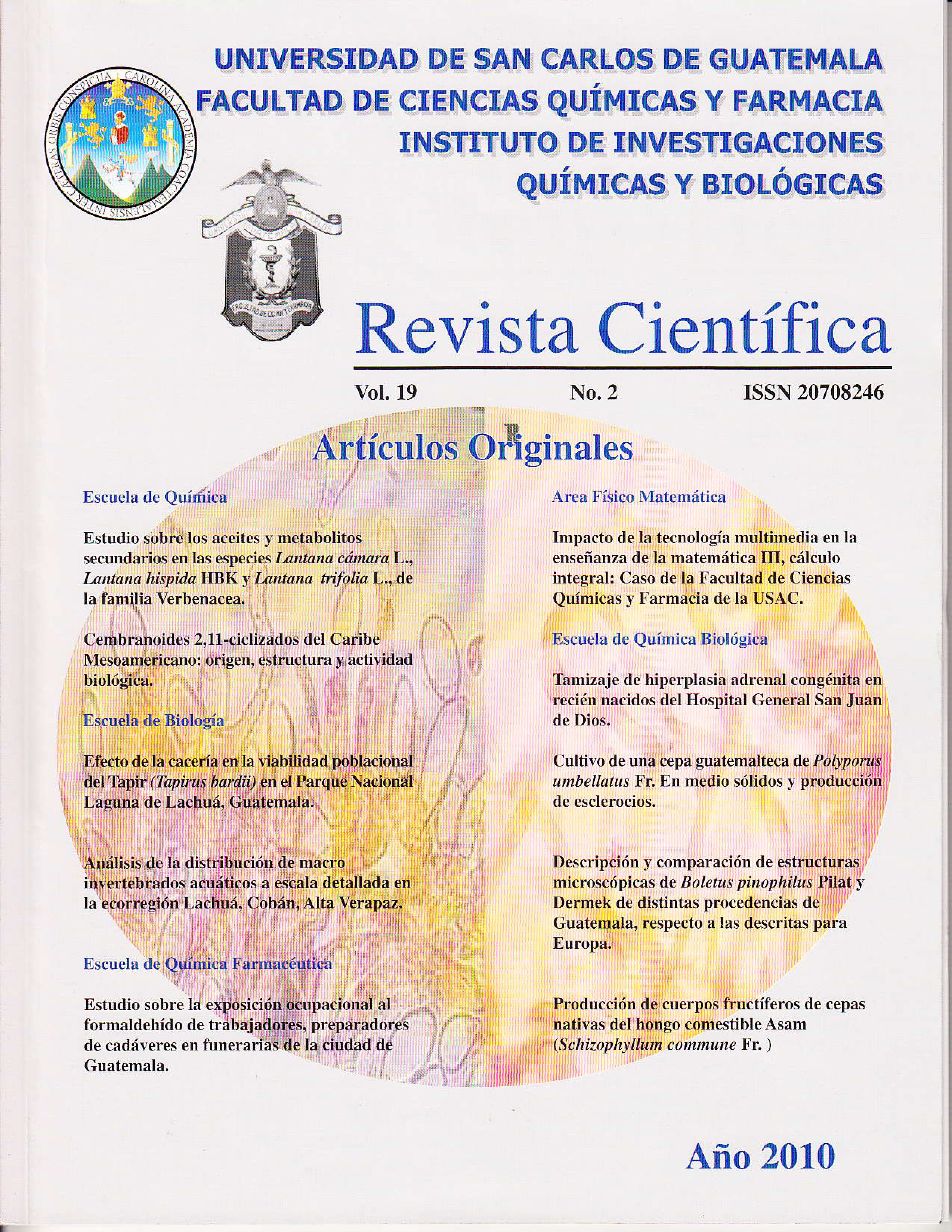Study on occupational exposure to formaldehyde in workers preparing corpses in funeral homes in Guatemala City
DOI:
https://doi.org/10.54495/Rev.Cientifica.v19i2.156Keywords:
Formaldehyde, toxic effect, exposition, mortuary, dermatological sign and symptoms, corpses preparationAbstract
The formaldehyde its consider to be a high risk substance, chemic that belongs to the aldehids (the simplestcompound of this family) its highly volatile and very flammable, the chemical formula is H2CO3 and its usagewithout personal protection can be harmful to the persons health. Since much years ago its consider, to be theclassic human tissue conserven to preserve corpses until they're buried. The common technique for doing this isan intra-arterial injection of this liquid after draining rhe vain blood, together with the treatment of the big cavities(skull, thorax and abdomen) and their muscular masses. Light to severe damages can be caused to people's heswho work at mortuarys preserving andpreparing corpses, ifthey are in contact with this substance forlong periodsof time and inadequate protection measures. This work evaluated the exposure of several mortuary workers toformaldehyde in Guatemala City. There were 28 mortuary workers that are exposed to formaldehyde that workedin the 12 mortuaries in Guatemala City.Westudied several toxic effects produced by formaldehyde in the 28workers that were exposed 3.6 hours dairy for an average period of 1 1 years, who where ah men in rhe ages of19 to56years. The signs and symptoms offormaldehyde exposure on the mortuary workers were recoveredwithastencil made for this only purpose and completed with interviews and careful observation.The frequency of dermatologic signs and symptoms of the exposure to formaldehyde was found high for peoplewho had a high level ofexposure to formaldehyde for long periods of time. The most frequently signs where:dryness of skin (60.7%). thickening of the skin sense by direct contact (64,3%). throat irritation (71.4%). ocularconjunctiva irritation (67.9%). dry mouth (67.9%), hypoalgesia (diminish capacity to sense stimuli’) (50%).The age. prolonged periodsofw'ork. less usage of protection equipment, seemed to make more frequently theappearance of signs and symptoms, but the frequency of conjunctiva irritation was higher on newworkersthathad less exposure to formaldehyde. The mortuaries in evaluation look some measures to control the exposure toformaldehyde of their workers but it was insufficient to avoid manifesting intoxication on some workers
Downloads
References
Bev-Lorraine Trac. Robert H. Drcisbach. 2003. Manual de toxicología clínica de drcisbach: Prevención, diagnóstico y tratamiento. El Manual Moderno. 7 a . Pp.180-182.
Carrillo A. 1973. Lociones de medicina forense y toxicología. ColecciónAula. Editorial Universitaria. Guatemala. Gisbert Calabuig. 2004. Medicina legal y toxicología. 6a. Edición. Editorial Masson. Barcelona, España. Pp. 219-221.
Ladou, Joseph. 1999. Medicina laboral y ambiental. 2a. Edición. Editorial Manual Moderno. México-Colombia. Pp. 506-508, https://doi.org/10.1016/S0008-6363(98)00295-8
Moret. O. 2004. Un caso de intoxicación crónica por formaldehído universidad de los andes Facultad de Medicina. Mérida, Venezuela.
Navarro Batres. 2005. Medicina legal. Editorial Universitaria. Tomo I y 2. Guatemala. IX.7. Oxford University. 2006. Risk Phrases. (En línea) Estados Unidos. Consultado en Agosto 2007. Disponible en http://ptcl.chem.ox.ac.uk/MSDS/risk_phrases.html
The hsci Project. 2007. Safety data for formaldehyde, 37% solution (En línea) Estados Unidos. Consultado en Septiembre de 2007 . Disponibleen http://ptcl.chem.ox.ac.uk/MSDS/FO/formaldehyde.html Hand-on Science. Oxford University. 2007.
Safety data for formaldehyde, 37%. Solution. (En línea) Estados Unidos. Consultado en septiembre de 2007. Disponibleen http://www.mtas.es/insht/ipesnspn/nspnsynf.htm
Jay A. Brown. M.D., M.P.H. 2007. Occupational Exposure to Hazardous Agents. (En Línea) Estados Unidos. Consultado en Septiembre de 2007. Disponible en http://hazmap.nlm.nih.gov/egi-bin/hazmap_generic?Tbl=tb1agents&id=271
Departamento de Salud y Servicios Humanos de EE. UU., Servicio de Salud Pública. Agencia para Sustancias Tóxicas y el Registro de Enfermedades. (ATSDR) . 1999. Reseña Toxicoiógica del Formaldehído (en línea) Atlanta. G.A. consultado en mayo 2008. Disponible en http://wxvw.atsdr.cdc.gov/es/toxfaqs/es_tfacts111.html
International Agency for Research on Cáncer. 2007. IARC News. (En línea) Eyon, France.Consultado en marzo 2008. Disponible en http://www.iarc.fr
Academia de Ciencics Mediques i de la Saint de Catalunya i de Balcars. 2008. Monografías de desinfectantes de uso hospitalario. (En línea) Barcelona, España. Consultado en febrero 2008. Disponible en http://www.academia.cat/societats/farmcl/11ibre/higiene/43.pdf
Ordóñez Ga. Tafur La, Bedoya L. Castillo M, Estrada E, Flórez S. Millán Je. 2003. Consecuencias respiratorias desencadenadas por exposición al formaldehído en los embaí sumadores de santiago de cali. Universidad Santiago de Cali. Colombia.
Leikin. Jerrold / Frank P. Paloucek. 2002. Poisoning & toxicology handbook. 3ed. Ed. Lexi-Comp. Apha. Canadá, 1523 pg.
Baselt, Randall C. 1980. Biological monitoring methods for industrial chemicals. Biomedical. U.S.A.,
Maili Mercadal. 2002. Medicina del trabajo. 2a. Ed. Masson. Barcelona, pp. 147. 685.
Hunter, Donald. 1985. Enfermedades laborales. Jims. España, pp 896-897.
3M. 2006. Occupational Health and Environmental Safety Division. (En línea). Estados Unidos de América. Consultado en junio 2008. Disponible en http://www.3M.com/occsafety/htm/software.html
Downloads
Published
How to Cite
Issue
Section
License
Copyright (c) 2010 N. Cerna, M. Guzmán

This work is licensed under a Creative Commons Attribution 4.0 International License.
Authors who publish with this journal agree to the following terms:
- Authors retain copyright and grant the journal right of first publication with the work simultaneously licensed under a Creative Commons Attribution License 4.0 that allows others to share the work with an acknowledgement of the work's authorship and initial publication in this journal.
- Authors are able to enter into separate, additional contractual arrangements for the non-exclusive distribution of the journal's published version of the work (e.g., post it to an institutional repository or publish it in a book), with an acknowledgement of its initial publication in this journal.
- Authors are permitted and encouraged to post their work online (e.g., in institutional repositories or on their website) prior to and during the submission process, as it can lead to productive exchanges, as well as earlier and greater citation of published work.









